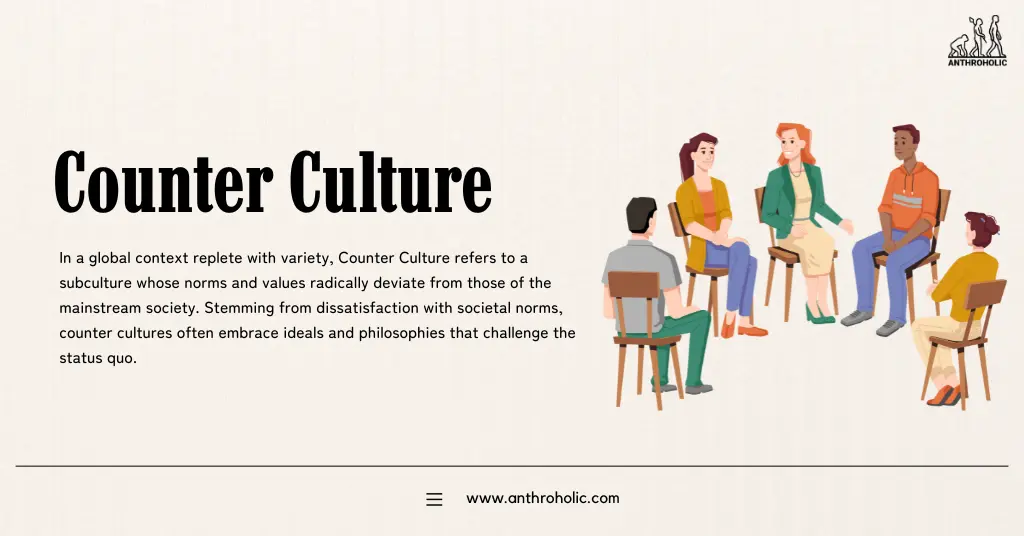AI Answer Evaluation Platform Live Now. Try Free Answer Evaluation Now
Counter Culture
In a global context replete with variety, Counter Culture refers to a subculture whose norms and values radically deviate from those of the mainstream society. Stemming from dissatisfaction with societal norms, counter cultures often embrace ideals and philosophies that challenge the status quo.

History of Counter Culture
Counter cultures have emerged time and again across various societies throughout history. However, the most well-known is the counter culture movement of the 1960s and 1970s in the United States and Europe.
Table 1: Notable Counter Culture Movements
| Time Period | Movement | Key Ideas |
|---|---|---|
| 1920s | Flappers | Women’s liberation, sexual freedom |
| 1940s-1950s | Beatniks | Disdain for materialism, embrace of Eastern spirituality |
| 1960s-1970s | Hippies | Peace, love, communal living, environmentalism |
The 1960s: The Counter Culture Movement Par Excellence
The 1960s was a turbulent period marked by civil rights movements, anti-war protests, and the call for sexual liberation and gender equality. Many youths rejected conventional societal norms, giving rise to the ‘hippie’ movement, arguably the most recognizable counter culture to date.
A. Principles and Practices
- Communal Living: Hippies often lived in tight-knit communities, sharing resources and responsibilities.
- Non-Violence and Peace: Opposition to the Vietnam War was central, with peace and love being the guiding principles.
- Embrace of Eastern Spirituality: Many adopted spiritual practices from the East, such as meditation and yoga.
- Environmentalist Stance: They pioneered environmental awareness, promoting sustainable living.
Influence and Legacy
While counter cultures often face backlash, their impacts can be far-reaching, reshaping societal norms and even influencing policy.
Table 2: Legacy of Counter Culture Movements
| Impact | Explanation |
|---|---|
| Fashion | Counter cultures often adopt distinctive styles, influencing mainstream fashion trends. For example, the hippie movement popularized tie-dye and bell-bottom jeans. |
| Music | Music is a key element, often serving as a form of protest. The Beatles and Bob Dylan are notable for their counter cultural messages. |
| Policies | The push against the Vietnam War influenced U.S. foreign policy. The hippies’ focus on environmentalism also paved the way for early environmental legislation. |
| Social Norms | Counter cultures challenge existing societal norms, facilitating societal change. The sexual revolution and the women’s liberation movement influenced changes in attitudes towards sex and gender roles. |
An Anthropological Perspective on Counter Culture
It’s crucial to understand that counter cultures aren’t simply arbitrary; they are borne out of larger societal structures, historical contexts, and cultural processes.
Counter Culture as a Cultural Response
Anthropologists view counter culture as a cultural response to certain changes or conditions within a society. Disparities in economic conditions, racial or gender inequalities, war, or rapid technological changes can all spur the emergence of counter cultures.
The 1960s Counter Culture
Take the 1960s counter culture movement, for instance. An anthropological perspective would examine the broader societal structures that led to its emergence. It could involve the economic prosperity of post-WWII America that gave younger generations the freedom to question societal norms, the Vietnam War that led to a heightened sense of political consciousness, or the Civil Rights Movement that incited a broad rethinking of social equality.
Counter Culture as Symbolic Systems
Anthropologists also view counter cultures as symbolic systems, a set of significant symbols or practices that hold meaning for the group. These can range from clothing styles, music preferences, to distinctive language or rituals.
The Hippie Movement
In the case of the hippie movement, anthropologists would examine symbols such as the peace sign, tie-dye clothing, or communal living. These symbols weren’t chosen arbitrarily; they were symbolic rejections of mainstream culture — a call for peace against war, a preference for simplicity and communalism against consumerism, and so on.
Counter Cultures and Identity Formation
Identity formation is a key interest in anthropology, and counter cultures often play a significant role in this process. Members of a counter culture often form their identity in opposition to mainstream society. This opposition is not just ideological but often extends to visual and behavioral identifiers.
Punk Movement
Consider the punk movement, with its raw, aggressive music, distinctive fashion, and DIY ethos. This was not just a rejection of mainstream music and culture but a redefinition of self-identity that differentiated the ‘punks’ from the mainstream.
Cultural Change and Integration
Finally, from an anthropological perspective, counter cultures are critical agents of cultural change. While initially seen as oppositional, many ideas and values originating from counter cultures gradually integrate into the mainstream culture, causing societal shifts.
Conclusion: Counter Culture in the Modern Day
Counter cultures continue to form and evolve in response to societal changes. Current examples include the cyberpunk movement, challenging conventional views on technology and humanity’s future, and the body positivity movement, advocating for acceptance and love of all body types.
In essence, counter cultures are agents of change, sparking dialogue, reflection, and eventually societal transformation. They highlight the capacity for individual and collective resistance to mainstream culture, reminding us that change is often born from the margins.
References
- Roszak, T. (1969). The Making of a Counter Culture. Anchor Books.
- Hebdige, D. (1979). Subculture: The Meaning of Style. Methuen & Co Ltd.
- Turner, F. (2006). From Counterculture to Cyberculture: Stewart Brand, the Whole Earth Network, and the Rise of Digital Utopianism. The University of Chicago Press.
- Eriksen, T. H. (2001). Small places, large issues: An introduction to social and cultural anthropology. Pluto Press.
- Marcus, G. E., & Fischer, M. M. (1986). Anthropology as Cultural Critique: An Experimental Moment in the Human Sciences. The University of Chicago Press.
- Hebdige, D. (1979). Subculture: The Meaning of Style. Methuen & Co Ltd.




